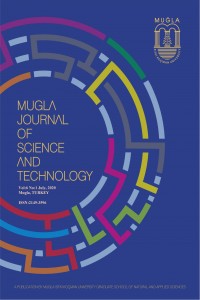Öz
Kaynakça
- [1] Yumrutaş, R., Kaşka, Ö., Yıldırım, E., “Estimation of total equivalent temperature difference values for multilayer walls and flat roofs by using periodic solution”, Building and Environment, 42, 1878–1885, 2007.
- [2] Bansal, K., Chowdhury, S., Gopal, M.R., “Development of CLTD values for buildings located in Kolkata, India”, Applied Thermal Engineering, 28, 1127–1137, 2008.
- [3] Yumrutas, R., Unsal, M., Kanoglu, M., “Periodic solution of transient heat flow through multilayer walls and flat roofs by complex finite Fourier transform technique”, Building and Environment, 40, 1117–1125, 2005.
- [4] Wang, S.K., Handbook of air conditioning and refrigeration, McGraw-Hill, New York, 2001.
- [5] ASHRAE, ASHRAE handbook-fundamentals, ASHRAE, Atlanta, 1993.
- [6] Chaiyapinunt, S., Mangkornsaksit, K., and Phueakphongsuriya, B., “Development of cooling load temperature differential values for building envelopes in Thailand.”, Journal of the Chinese Institute of Engineers, 27, 677-688, 2004.
- [7] Mackey, C.O., Wright, L.T., “Periodic heat flow-homogeneous walls or roofs”, ASHVE Transactions, 50, 293-312, 1944.
- [8] Mackey CO, Wright LT. “Periodic heat flow-composite walls or roofs”, ASHVE Transaction,s 52, 283, 1946.
- [9] Ruivo, C. R., Ferreira, P. M., and Vaz, D. C., “On the error of calculation of heat gains through walls by methods using constant decrement factor and time lag values”, Energy and Buildings, 60, 252-261, 2013.
- [10] Zainal, O.A., and Yumrutas, R., “Validation of periodic solution for computing CLTD (cooling load temperature difference) values for building walls and flat roofs”, Energy, 82, 758–768, 2015.
- [11] American Society of Heating, Refrigeration and Air Conditioning Engineers, ASHRAE Handbook of Fundamentals, Atlanta, 1997.
- [12] American Society of Heating, Refrigeration and Air Conditioning Engineers, ASHRAE Handbook of Fundamentals, Atlanta, 2005.
Öz
The estimation of the cooling load through the building envelope is an essential task in the selection of proper HVAC system components that influences the building’s performance. For this task, ASHRAE has presented several methods to calculate the building cooling load due to heat gain, such as the total equivalent temperature difference method (TETD), the cooling load temperature difference method (CLTD), and the radiant time series method (RTS). The present study aims to explore the accuracies of those calculation methods in terms of energy efficiency. In this regard, an analytical solution method utilizing Complex Finite Fourier Transform Technique (CFFT) was developed for the calculation of cooling load due to heat gain to compare the temperature differences obtained from the TETD and CLTD methods. Then, a computer program was prepared in MATLAB to perform the calculations based on an analytical methodology. Besides, the estimated CLTD and TETD values by the CFFT were compared with those values presented in the Handbook of the ASHRAE. The calculation results revealed there is a good agreement between the analytical and presented results in the ASHRAE Manual for the selected building envelopes. However, several differences were found between the estimated TETD and CLTD cooling load values and those presented in the Handbook of ASHRAE.
Anahtar Kelimeler
Building envelope cooling load Heat Gain Cooling Load Calculation Methods
Kaynakça
- [1] Yumrutaş, R., Kaşka, Ö., Yıldırım, E., “Estimation of total equivalent temperature difference values for multilayer walls and flat roofs by using periodic solution”, Building and Environment, 42, 1878–1885, 2007.
- [2] Bansal, K., Chowdhury, S., Gopal, M.R., “Development of CLTD values for buildings located in Kolkata, India”, Applied Thermal Engineering, 28, 1127–1137, 2008.
- [3] Yumrutas, R., Unsal, M., Kanoglu, M., “Periodic solution of transient heat flow through multilayer walls and flat roofs by complex finite Fourier transform technique”, Building and Environment, 40, 1117–1125, 2005.
- [4] Wang, S.K., Handbook of air conditioning and refrigeration, McGraw-Hill, New York, 2001.
- [5] ASHRAE, ASHRAE handbook-fundamentals, ASHRAE, Atlanta, 1993.
- [6] Chaiyapinunt, S., Mangkornsaksit, K., and Phueakphongsuriya, B., “Development of cooling load temperature differential values for building envelopes in Thailand.”, Journal of the Chinese Institute of Engineers, 27, 677-688, 2004.
- [7] Mackey, C.O., Wright, L.T., “Periodic heat flow-homogeneous walls or roofs”, ASHVE Transactions, 50, 293-312, 1944.
- [8] Mackey CO, Wright LT. “Periodic heat flow-composite walls or roofs”, ASHVE Transaction,s 52, 283, 1946.
- [9] Ruivo, C. R., Ferreira, P. M., and Vaz, D. C., “On the error of calculation of heat gains through walls by methods using constant decrement factor and time lag values”, Energy and Buildings, 60, 252-261, 2013.
- [10] Zainal, O.A., and Yumrutas, R., “Validation of periodic solution for computing CLTD (cooling load temperature difference) values for building walls and flat roofs”, Energy, 82, 758–768, 2015.
- [11] American Society of Heating, Refrigeration and Air Conditioning Engineers, ASHRAE Handbook of Fundamentals, Atlanta, 1997.
- [12] American Society of Heating, Refrigeration and Air Conditioning Engineers, ASHRAE Handbook of Fundamentals, Atlanta, 2005.
Ayrıntılar
| Birincil Dil | İngilizce |
|---|---|
| Konular | Mühendislik |
| Bölüm | Makaleler |
| Yazarlar | |
| Yayımlanma Tarihi | 30 Haziran 2020 |
| Yayımlandığı Sayı | Yıl 2020 Cilt: 6 Sayı: 1 |



